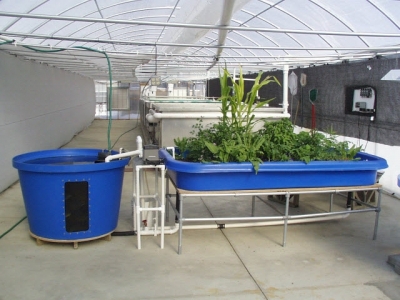How to set up an aquaponics system

Starting small will not necessarily give you an accurate idea of what to expect when going commercial.
By far the greatest number of enquiries into aquaculture I receive are from people wanting to set up a small backyard or pilot project. They want to ‘try it out’ before committing to a large cash investment. But small re-circulating systems can rarely be extrapolated to large commercial systems. For one thing, the volume of water in a backyard set-up is so small that it can change quality drastically in a short space of time, compromising the fish’s health.
The good news is that large systems are much more resilient, to both temperature and chemical changes. Also, economies of scale come into play. Another factor to be considered is that if you use hothouse tunnels to obtain free heating, and wish to expand your operation, the cost may prove prohibitive as tunnels are so expensive.

Basic principles
There are two components to every system: the grow-out tanks and the filtration. Wherever possible, the latter should be recessed in the ground so that the fish grow-out tanks can drain into it by gravity, with the clean water then pumped back to the fish. In the case of aquaponic systems (fish and plant culture), it is the other way around. The fish tanks are at the lowest point and water is pumped into the plant-growing containers, where it filters through the plant-growing medium, and is then gravity-fed back to the fish tanks.
In a re-circulating system, filtration is the one aspect that seems to cause the most confusion. The golden rule is that filter volume should equal not less than 30% of grow-out tank volume. This means that those off-the-shelf ‘filters’ available at pet shops are totally inadequate for the job. As for the pressure sand filters designed for swimming pools – avoid them at all costs. They are designed for chlorinated water, and not for fish waste, algae and all the ‘gunk’ associated with living organisms!
Filtration
The four elements of filtration are sediment settlement and removal, mechanical filtration of suspended particles, biological filtration of dissolved ammonia and nitrite, and dilution of the final product, nitrate. No single gadget purchased from a shop can accomplish all these stages – you need to build your own. Sludge settlement is best done by slowing the water down and allowing faecal waste to sink in a large, deep V-bottomed tank, from which the sludge can be siphoned out daily.
Next comes mechanical filtration, which is where the water passes slowly through a container filled with gravel, broken bricks or similar material that intercepts the suspended ‘bits’. At this stage, the water should be clear of particles, but will still contain toxic ammonia.

The bio-filter is basically a large container of inert material such as bio-balls, crumpled netting or plastic shavings which become coated with beneficial bacteria that ‘clean’ the water by converting the toxins to nitrate (basically fertiliser). Nitrate is less toxic to fish, but must be diluted by doing large-scale water changes regularly. Any filtration that skips one of these essential stages will compromise the fishes’ health.
Self-cleaning tanks
Needless to say, any device or system that helps to remove the by-products of feeding the fish – solid and dissolved toxins – will improve their health. Self-cleaning tanks are therefore an essential component of even the smallest set-up.
Nicholas James is an ichthyologist and hatchery owner.
Related news
 Cold-tolerant tilapia can weather winter’s chill
Cold-tolerant tilapia can weather winter’s chill Taking tilapia cold tolerance ranges into account shows how just a few degrees can make for a worry-free season.
 Moving fish
Moving fish Special care needs to be taken when moving fish in order to minimise their stress levels and thus prevent unnecessary deaths.
 Choosing the right aquaculture technology
Choosing the right aquaculture technology Successful aquaculture is all about making a profit. Make sure your system is affordable and appropriate